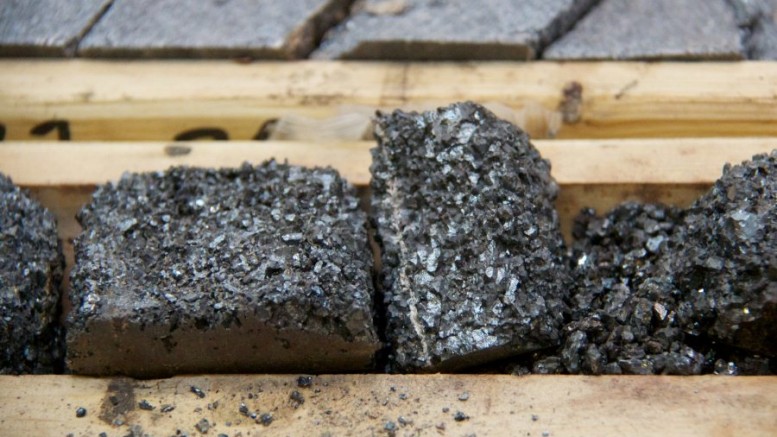Champion Minerals (CHM-T) has traded higher on news that its 100%-owned Oil Can iron ore deposit, 6 km north of its flagship Fire Lake North project in the southern end of the Labrador trough, contains nearly 1 billion tonnes of magnetite-rich oxides.
A maiden resource estimate puts Oil Can’s in-pit optimized inferred resource for the magnetite-rich oxides at a 15% iron cut-off grade, at 967 million tonnes grading 33.2% total iron. That’s nearly four times larger than Raymond James analyst Adam Low expected of Oil Can’s initial resource, and “with an above-average grade” for the region.
The deposit consists of a magnetite-rich iron oxide formation and a mixed magnetite-silicate iron formation hosted in five domains separated by possible thrust faults. Inferred resources for the magnetite-rich iron oxide formation total 972 million tonnes grading 33.2% total iron at a 15% cut-off grade, in addition to 924 million tonnes grading 24.1% total iron for the mixed magnetite-silicate iron formation.
Champion Minerals is evaluating whether it should integrate the resources at Oil Can and Fire Lake North to create a project that it says could one day support annual concentrate production of up to 20 million tonnes of specular hematite sinter feed from Fire Lake North, and up to 20 million tonnes of magnetite sinter feed from Oil Can.
The company says it may combine its Bellechasse and Midway properties with Fire Lake North and Oil Can into a Consolidated Fire Lake North project, because Bellechasse and Midway are contiguous to the two properties.
“The combination of these projects results in a resource of 3.2 billion tonnes grading 28.7% iron,” Daniel Greenspan, an analyst at Macquarie Equities Research, writes in a client note, adding that the company-wide resource totals more than 4.6 billion tonnes.
“With a growing resource, larger-scale production from the consolidated Fire Lake North project is increasingly likely,” he says. “At this stage, there is limited metallurgical test work completed at Oil Can, but early results indicate that a relatively coarse grind and magnetic separation could result in the production of a sinter-feed concentrate.”
Greenspan has a 12-month target price on the stock of $3 per share. Champion Minerals traded at $1.12 per share within a 52-week range of 72¢–$2.27 at presstime.
Upcoming catalysts for the company include an updated resource estimate for Fire Lake North in the late third quarter or early fourth quarter, and a feasibility study before year-end.
Low of Raymond James expects Champion will build one processing line that will handle the predominantly specular-hematite ore from Fire Lake North and a second processing line to beneficiate the predominantly magnetite ore from Oil Can and the residual magnetite tailings from the first line.
He also predicts the mine will start production in early 2016 at an initial 10 million tonnes per year of iron ore sinter-fines concentrate, which could reach 17.3 million tonnes a year by 2020. He forecasts a mine life of 33 years, up from his previous forecast of 23 years, and a concentrate grade of 65% iron.
Low has a 12-month target price on the stock of $3.15, up from his previous $3-per-share target, and has upped Champion’s net asset value (NAV) from $7.47 to $7.93.
Robin Kozar of RBC Capital Markets says Champion offers shareholders “exposure to a development-stage iron ore company with exceptional resource-growth potential,” and has a target price on the stock of $2 per share.
“Our current NAV of $5.06 assumes Champion produces an average 8.7 million tonnes of iron ore concentrates over the first 25 years of mine life,” the analyst writes in a research note. “Adding a half-billion tonne of iron ore reserves to extend the mine life increases our NAV from $5.06 to $5.59. Assuming Champion doubles production to 17 million tonnes per annum at a cost of US$1.3 billion, or $160 per tonne of installed production capacity, our NAV would increase to $10.41 per share.”
Kozar adds that development timelines and cost structure result in his NAV having significant leverage to long-term iron ore prices. And while there are “considerable development risks,” including getting a rail agreement to move the iron ore product, he says the shares “are attractive at current levels given the potential near-term catalysts, exploration upside and long-term takeout potential.”
The Consolidated Fire North property is adjacent and north of ArcelorMittal’s operating Fire Lake mine, and 60 km south of Cliffs Natural Resources’ (CLF-N) Bloom Lake mine in northeastern Quebec.


Be the first to comment on "Oil Can’s iron ore lifts Champion Minerals"